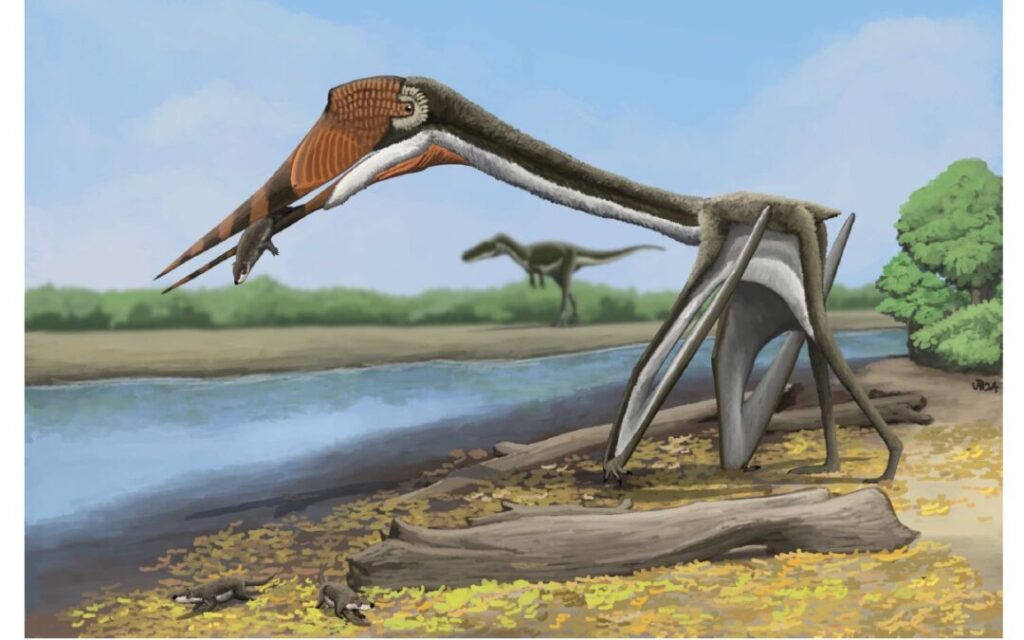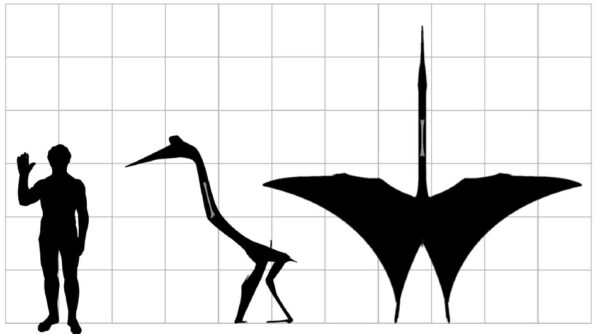
This rendering is a speculative life restoration of the Infernodrakon hastocollis dinosaur as it is foraging. (Illustration by Jun-Hyeok Jang as it appeared in a recent edition of the Journal of Vertebrate Paleontology.)
As prehistoric creature names go, “Infernodrakon” (i.e., “dragon from hell”) is—if you’ll pardon the pun—fire.
Credit a University of Wisconsin—Oshkosh professor as part of the team of paleontologists to discover this new species of pterosaur, the winged reptiles that coexisted with Tyrannosaurus rex and other dinosaur species about 67 million years ago.
The new-to-us creature’s scientific name is Infernodrakon hostacollis. It is technically a cousin of the dinosaurs. And UWO Geology Professor Joe Peterson was among its discoverers.
Peterson said 23 years ago he was part of a team that found a telltale bone from the animal’s lanky neck. The group figured it belonged to a known pterosaur.
More than 20 years later, a deeper analysis of that single bone was key to its identification and confirmation as a new pterosaur genus and species.
“We first found this bone around 2002,” said Peterson, adding that the fossil turned up during the excavation of the site of a juvenile T. rex in Hell Creek, Montana, when he was an undergraduate student. “We knew it was a pterosaur at that time, but we didn’t know which one.”
Pterosaurs ranged from “the size of a small aircraft to the size of sparrow,” Peterson said. Infernodrakon’s wingspan clocked in at approximately 16-feet-wide and, when landed on the ground, would have stood as tall as a human.

This rendering of a juvenile pterosaur dinosaur, center, shows it’s human-sized height while standing and a wingspan of approximately 16-feet wide. (Artwork as published in Journal of Vertebrate Paleontology.)
“Pterosaurs evolved before birds did,” he said. “These were the first vertebrate animals to achieve flight.”
Peterson said when the Infernodrakon fossil was first collected in the early 2000s, examination clearly suggested it was a relative of Quetzalcoatlus, the largest of the pterosaurs. But not until roughly four years ago, when a graduate student from Berkeley reexamined the creature’s neck bone, did the true discovery come into focus.
“So, we looked at it again, compared it to the new literature on the species and realized this is something totally different than we’ve ever seen,” he said.
Artist renderings of the somewhat-pelican-like Infernodrakon included in the research team’s study published in the Journal of Vertebrate Paleontology include a juvenile T. rex in the background, an homage to the original star dinosaur of the dig site where the bone was found.
Peterson said the fact that the Infernodrakon bone, originally considered an unremarkable fossil, is now key to the new discovery says much about the never-settled process of science.
“That first (juvenile T. rex) paper we published on the specimen in 2005 was the first paper I ever published,” Peterson said. “Now, it’s many years later, and we’re admitting we were wrong. That’s how science evolves… This is not just about pterosaurs but how science works. We’re always correcting ourselves.”
When he’s not teaching and mentoring researchers at UWO, Peterson’s scholarship “focuses on trying to understand how things become fossilized and what these animals went through.”
He has also earned notice for some of his previous research including a fascinating study into juvenile Tyrannosaur bite-force.
This fall, he teaches UWO courses on dinosaurs in the age of reptiles and upper-level paleontology.
Meanwhile, he and the Infernodrakon research team await peer feedback about their findings on another creature of late-Cretaceous, a period of Earth’s history when Alaska harbored palm trees and crocodiles and there was likely no permanent ice on the planet.
“The real peer review comes now when other researchers play with this idea,” he said. “One thing it’s doing is making us think more about the diversity of organisms at that time… Here we are looking not just at birds and snakes and lizards and fish but these giant flying reptiles. It’s helping bring that picture of that ecosystem into focus, and we’re getting more and more interesting organisms alive at that time.”
Written by Alex Hummel
Link to original story: https://www.uwosh.edu/today/127489/uwos-dino-doc-among-team-to-discover-new-human-height-pterosaur/
